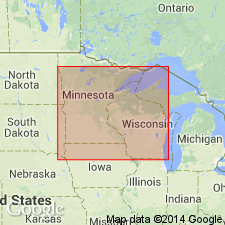
- Usage in publication:
-
- Algoman revolution*
- Modifications:
-
- Overview
- AAPG geologic province:
-
- Lake Superior region
Summary:
Algoman revolution. Term applied by A.C. Lawson to a pre-Cambrian epoch of granitic intrusion which he considered to have immediately preceded the formation of the †Animikie rocks, but which some other geologists place at a lower horizon in the Huronian series, and which still other geologists regard as Laurentian. (See USGS Bull. 769, p. 123-124). C.K. Leith, R.J. Lund, and A. Leith, 1935 (USGS Prof. Paper 184), placed it below lower Huronian and above Knife Lake series (tentatively classified as pre-Huronian and post-Laurentian, but which may eventually prove to be lower Huronian).
Source: US geologic names lexicon (USGS Bull. 896, p. 31).

- Usage in publication:
-
- Algoman orogeny*
- Modifications:
-
- Overview
- AAPG geologic province:
-
- Lake Superior region
Summary:
The younger of two periods of deformation and magmatic activity distinguished by Lawson (1888, 1913). In his view, the Laurentian rocks (older) were intruded into a dominantly metasedimentary sequence (called the Coutchiching) that in turn was overlain by a dominantly metavolcanic sequence (called the Keweetin). After a period of erosion, a second metasedimentary sequence (called the Seine) was deposited and it, as well as the older rocks, was deformed a second time when the Algoman intrusions were emplaced. The concept of a two-fold subdivision separated by a post-Laurentian unconformity persisted well into the middle of the 20th Century. However, any volcanic-sedimentary sequence in the Superior province may consists of a single mafic to felsic to sedimentary assemblage, or it may consist of one or more assemblages repeated in space and time. All major rock-forming events in the Rainy Lake area of northern MN (Lake Superior region) and southern ON occurred between about 2,700 and 2,600 m.y. age. Peterson and others (1972) obtained a younger Rb-Sr age for the so-called Algoman granites of 2,485 +/-90 m.y. Such discrepancies between older U-Pb, and apparently younger Rb-Sr whole rock, potassium-argon, and Rb-Sr mineral ages are common in the greenstone-granite terrane of northern MN. Age of Algoman is considered Late Archean. Correlation chart.
Source: GNU records (USGS DDS-6; Denver GNULEX).
For more information, please contact Nancy Stamm, Geologic Names Committee Secretary.
Asterisk (*) indicates published by U.S. Geological Survey authors.
"No current usage" (†) implies that a name has been abandoned or has fallen into disuse. Former usage and, if known, replacement name given in parentheses ( ).
Slash (/) indicates name conflicts with nomenclatural guidelines (CSN, 1933; ACSN, 1961, 1970; NACSN, 1983, 2005, 2021). May be explained within brackets ([ ]).

